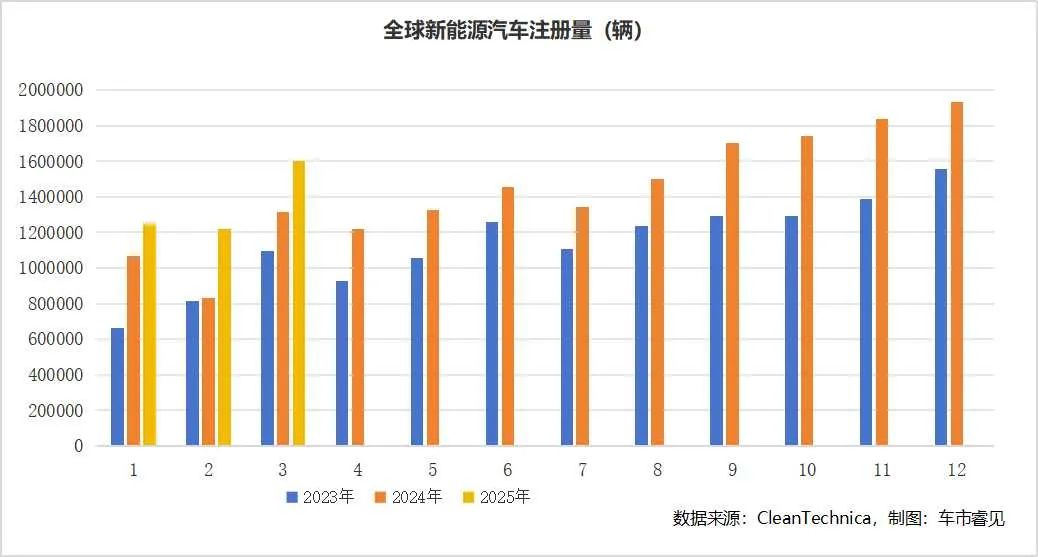Global New Energy Vehicle Market: Sales Surge as China's EVs Spark 'Catalyst Effect'
![]() 05/14 2025
05/14 2025
![]() 628
628
In the nascent stages of Tesla's entry into China, it emerged as a pivotal 'catalyst' for the nation's burgeoning new energy vehicle industry. By leveraging advanced technology, it compelled Chinese automakers to expedite research and development, foster technological advancements, and integrate new energy supply chains, thereby catalyzing the improvement and upgrading of the entire industry chain. Currently, as Chinese new energy vehicles venture abroad and integrate into the global automotive landscape, Chinese automakers have transformed into 'catalysts' within the global market, propelling the rapid growth of the global new energy vehicle industry.
From 2022 to 2024, electric vehicle sales in Brazil skyrocketed by over 500%, reaching 177,000 units in 2024, with Chinese brands contributing 64.5% of this increment. In Thailand, electric vehicle sales surged by 279%, accounting for 12% of total sales in 2024, with the top five best-selling brands all hailing from China. Mexico witnessed similar rapid growth, while Australia saw a 145% increase in sales over the past two years. Notably, in 2024, BYD ascended to become the second most popular electric vehicle brand in Australia, trailing only Tesla. Bloomberg research highlights a common trait among these markets experiencing surging electric vehicle sales: they are relatively receptive to Chinese automakers, introducing cost-effective models from brands like BYD and Geely, and swiftly enhancing local industrial chains through technology spillover effects.
Taking Brazil as a case study, the country implements phased tax incentives for the import of electric vehicles and components to incentivize local production. BYD, GAC, and Great Wall Motors have all established manufacturing facilities locally. BYD's plant in the state of Bahia enjoys a 30-year land tax exemption, while Great Wall Motors' plant in the state of São Paulo benefits from a 50% reduction in corporate income tax for 10 years. Chinese enterprises transferring electric drive technology to Brazilian local suppliers can apply for a 30% government subsidy for research and development funds. Furthermore, China and Brazil have accelerated the adaptation of Chinese models to local regulations through joint certification, significantly shortening the certification cycle.
In Europe, Norway has consistently exempted Chinese new energy vehicles from import tariffs. In 2024, the market share of Chinese electric vehicles in Norway surpassed 10%, with the penetration rate of pure electric vehicles reaching 96.4%, nearly achieving full electrification. The UK refrained from following the EU in imposing countervailing tariffs on Chinese electric vehicles, maintaining a standard import VAT of 20%, and the penetration rate of the new energy vehicle market attained 28.1% in 2024.
Bloomberg contends that the openness of overseas countries/regions to Chinese new energy vehicle enterprises is positively correlated with the adoption speed of new energy vehicles in those regions. The aforementioned cases affirm this perspective. Presently, Thailand's electric vehicle adoption rate surpasses that of the United States, while Brazil outpaces Japan. This development model challenges the conventional wisdom that electric vehicle adoption must be led by wealthier countries in a 'top-down' manner.
The driving impact of Chinese new energy vehicle enterprises on overseas markets is evident in urging local automakers to invest genuine efforts into electric vehicle product research and development by exporting market-competitive products and technologies. Generally, local automakers lack the courage to abandon profitable markets (for internal combustion engine vehicles), necessitating a newcomer to break the deadlock. Tesla, which entered the Chinese market early, has consistently played this role, and now Chinese automakers are also assuming such responsibilities abroad.
The 'catalyst effect' of Chinese automakers fosters the sustainable development of the global new energy vehicle industry. The latest global new energy vehicle sales data from research institution CleanTechnica reveals that in March 2025, global new energy vehicle sales exceeded 1.6 million units, marking a year-on-year increase of 25%. Among these, pure electric vehicle sales reached 1.1 million units, a year-on-year increase of 32%, while plug-in hybrid vehicle sales stood at approximately 500,000 units, a year-on-year increase of 14%. The overall market share of new energy vehicles reached 25% (with a market share of pure electric vehicles at 17%), an increase of 6 percentage points from February 2025, indicating that the global automotive market remains firmly on the path of electrification transformation.

Regarding the best-selling models, Chinese automakers occupy 17 positions within the top 20 on the list, with BYD alone featuring 9 models in the top 20. Tesla Model Y, BYD Song, and Tesla Model 3 continue to maintain the top three sales positions. Wuling Hongguang MINIEV, with the launch of its new five-door model, delivered 39,966 units in March, ranking fourth, up four positions from February, demonstrating outstanding performance. Geely Geometry Xingyuan registered over 30,000 units in March, ranking sixth.
In the global sales ranking for the first quarter, Geely Geometry Xingyuan secured fourth place with 89,215 registrations, while Xiaomi SU7 ranked seventh with 75,869 sales. Additionally, in the new energy pickup segment, BYD SHARK, released in 2024, sold 3,178 units globally in March, surpassing the leading model, the Ford F-150 Lightning (which sold 2,286 units in March), to become the world's best-selling new energy pickup. As BYD embarks on a global export mode, the sales share of its overseas markets reached 21% in March, compared to only 10% at the end of 2024.
By exporting and establishing factories overseas, Chinese automakers have accelerated technology diffusion and improved industrial chains, not only bolstering local new energy vehicle production capacity but also driving the coordinated development of upstream and downstream supporting industries, fostering a win-win model of 'technology export + local production'. Bloomberg emphasizes that to predict the regions with the fastest growth in the global electric vehicle market in the coming years, the policy inclusiveness of various countries towards Chinese new energy vehicle enterprises will emerge as a key indicator.
Typesetting | Zheng Li
Source | Bloomberg, CleanTechnica
Image Source | Shutterstock








